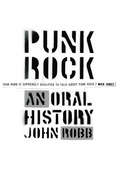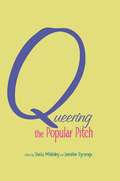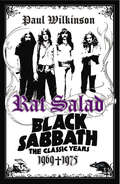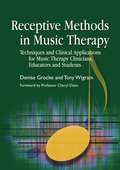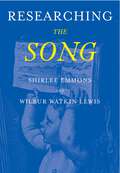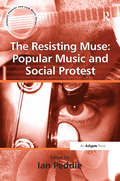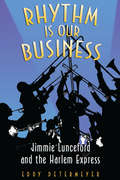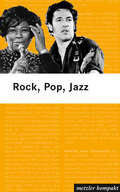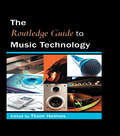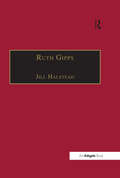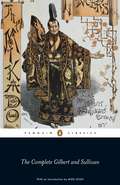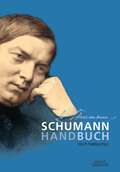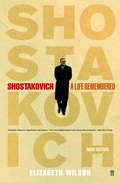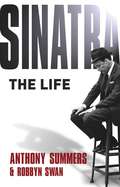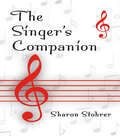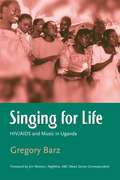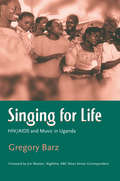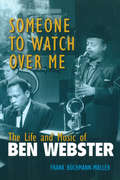- Table View
- List View
Punk Rock: An Oral History
by John Robb'To see The Clash on the White Riot tour was like discovering how to be a rock star: you just did it yourself. You didn't wait for someone to come and discover you. That was the most important thing that came out of punk... We came home and we cut our hair and bought skinny trousers. It was year zero. That was the moment for me' Billy BraggPunk Rock is a book like no other. It is an oral history of a radical movement which exploded in Seventies Britain. With its own clothes, hair, artwork, fanzines and radical politics, Punk boasted a DIY ethos that meant anyone could take part. The scene was uniquely vibrant and energetic, leaving an extraordinary legacy of notorious events, charismatic characters and inspirational music. John Robb has spent over a year interviewing more than 100 contributors including Glen Matlock, Mick Jones, Don Letts, Slash, Billy Bragg, Hugh Cornwell and Captain Sensible. Now, for the first time, they give the inside view on events such as The Sex Pistols' swearing live on the Bill Grundy TV show and staging their anti-Jubilee riverboat party on the Thames, famous gigs at The Roxy and 100 Club, and the groundbreaking records by The Pistols, The Clash, The Damned and others.From the widely debated roots of punk in the late-Sixties through to the fallout of the post-punk period in 1984, and the ongoing influence on today's bands, Punk Rock is the definitive oral history of an inimitable and exciting movement.
Queering the Popular Pitch
by Sheila Whiteley Jennifer RycengaQueering the Popular Pitch is a new collection of 19 essays that situate queering within the discourse of sex and sexuality in relation to popular music. This investigation addresses the changing debates within gay, lesbian and queer discourse in relation to the dissemination of musical texts -performance, cultural production and sexual meaning - situating music within the broader patterns of culture that it both mirrors and actively reproduces. The collection is divided into four parts:queering borders queer spaces hidden histories queer thoughts, mixed media. Queering the Popular Pitch will appeal to students of popular music, Gay and Lesbian studies. With case studies and essays by leading popular music scholars it provides insightful discourse in a growing field of musicological research.
Queering the Popular Pitch
by Sheila Whiteley Jennifer RycengaQueering the Popular Pitch is a new collection of 19 essays that situate queering within the discourse of sex and sexuality in relation to popular music. This investigation addresses the changing debates within gay, lesbian and queer discourse in relation to the dissemination of musical texts -performance, cultural production and sexual meaning - situating music within the broader patterns of culture that it both mirrors and actively reproduces. The collection is divided into four parts:queering borders queer spaces hidden histories queer thoughts, mixed media. Queering the Popular Pitch will appeal to students of popular music, Gay and Lesbian studies. With case studies and essays by leading popular music scholars it provides insightful discourse in a growing field of musicological research.
Rat Salad: Black Sabbath: The Classic Years 1969-1975
by Dr Paul WilkinsonBlack Sabbath are one of the most outrageous yet longest-lived bands in the history of rock 'n' roll. This informative, idiosyncratic and beguiling book paints a vivid picture of their colourful early history - interwoven with all the most crucial news stories of the time: from Vietnam to Bloody Sunday and the space programme.Where Rat Salad diverges from routes taken by most rock biographies, however, is in its detailed analysis of the band's first six albums. These chapters - think Ian MacDonald's Revolution in the Head meets Spinal Tap - occupy about half the book and persuasively explain the appeal of the music, its compositional artistry and its frequently audacious inventiveness.Original and passionate, Rat Salad embraces a remarkably diverse cast of characters - from Ozzy Osbourne himself and the other members of the band through to Edith Sitwell, Breugel the Elder, John Milton and Doris Day. The author's hand looms large in the piece. We see him both as a boy and man - from schoolboy ingenue to inveterate devotee - as he looks back at a life populated with love, sex, drugs and death played out against a backdrop of crucifixes and power chords.
Receptive Methods in Music Therapy: Techniques and Clinical Applications for Music Therapy Clinicians, Educators and Students
by Clare Kildea Denise Grocke Emily Shanahan Karen Hamlett Karin Schou Katerina Stathis Katrina Mcferran Matt Holmes Melina Roberts Susan B Wesely Tony WigramThis practical book describes the specific use of receptive (listening) methods and techniques in music therapy clinical practice and research, including relaxation with music for children and adults, the use of visualisation and imagery, music and collage, song-lyric discussion, vibroacoustic applications, music and movement techniques, and other forms of aesthetic listening to music. The authors explain these receptive methods of intervention using a format that enables practitioners to apply them in practice and make informed choices about music suitable for each of the different techniques. Protocols are described step-by-step, with reference to the necessary environment, conditions, skills and appropriate musical material. Receptive Methods in Music Therapy will prove indispensable to music therapy students, practitioners, educators and researchers.
Receptive Methods in Music Therapy: Techniques and Clinical Applications for Music Therapy Clinicians, Educators and Students (PDF)
by Clare Kildea Denise Grocke Emily Shanahan Karen Hamlett Karin Schou Katerina Stathis Katrina Mcferran Matt Holmes Melina Roberts Susan B Wesely Tony WigramThis practical book describes the specific use of receptive (listening) methods and techniques in music therapy clinical practice and research, including relaxation with music for children and adults, the use of visualisation and imagery, music and collage, song-lyric discussion, vibroacoustic applications, music and movement techniques, and other forms of aesthetic listening to music. The authors explain these receptive methods of intervention using a format that enables practitioners to apply them in practice and make informed choices about music suitable for each of the different techniques. Protocols are described step-by-step, with reference to the necessary environment, conditions, skills and appropriate musical material. Receptive Methods in Music Therapy will prove indispensable to music therapy students, practitioners, educators and researchers.
Researching the Song: A Lexicon
by Shirlee Emmons Wilbur Watkins LewisSingers are faced with a unique challenge among musicians: they must express not just the music, but the lyrics too. To effectively communicate the meaning behind these words, singers must understand the many references embedded in the vast international repertoire of great art songs. They must deal with the meaning of the lyrics, frequently in a language not their own and of a culture unfamiliar to them. From Zelter and Schubert to Rorem and Musto, Researching the Song serves as an invaluable guide for performers, teachers, and enthusiasts to the art song repertoire. Its more than 2,000 carefully researched entries supply information on most of the mythological, historical, geographical, and literary references contained in western art song. The authors explain the meaning of less familiar literary terms, figures, and authors referenced in song while placing songs in the context of larger literary sources. Readers will find entries dealing with art songs from the German, French, Italian, Russian, Spanish, South American, Greek, Finnish, Scandinavian, and both American and British English repertoires. Sources, narratives, and explanations of major song cycles are also given. Organized alphabetically, the lexicon includes brief biographies of poets, lists of composers who set each poet's work, bibliographic materials, and brief synopses of major works from which song texts were taken, including the plots of all Restoration theater works containing Purcell's vocal music. The more performers know and understand the literary elements of a song, the richer their communication will be. Researching the Song is a vital aid for singers and teachers in interpreting art songs and building song recital programs.
The Resisting Muse: Popular Music and Social Protest (Ashgate Popular and Folk Music Series)
by Ian PeddiePopular music has traditionally served as a rallying point for voices of opposition, across a huge variety of genres. This volume examines the various ways popular music has been deployed as anti-establishment and how such opposition both influences and responds to the music produced. Implicit in the notion of resistance is a broad adversarial hegemony against which opposition is measured. But it would be wrong to regard the music of popular protest as a kind of dialogue in league against 'the establishment'. Convenient though they are, such 'us and them' arguments bespeak a rather shop-worn stance redolent of youthful rebellion. It is much more fruitful to perceive the relationship as a complex dialectic where musical protest is as fluid as the audiences to which it appeals and the hegemonic structures it opposes. The book's contemporary focus (largely post-1975) allows for comprehensive coverage of extremely diverse forms of popular music in relation to the creation of communities of protest. Because such communities are fragmented and diverse, the shared experience and identity popular music purports is dependent upon an audience collectivity that is now difficult to presume. In this respect, The Resisting Muse examines how the forms and aims of social protest music are contingent upon the audience's ability to invest the music with the 'appropriate' political meaning. Amongst a plethora of artists, genres, and themes, highlights include discussions of Aboriginal rights and music, Bauhaus, Black Sabbath, Billy Bragg, Bono, Cassette culture, The Capitol Steps, Class, The Cure , DJ Spooky, Drum and Bass, Eminem, Farm Aid, Foxy Brown, Folk, Goldie, Gothicism, Woody Guthrie, Heavy Metal, Hip-hop, Independent/home publishing, Iron Maiden, Joy Division, Jungle, Led Zeppelin, Lil'Kim, Live Aid, Marilyn Manson, Bob Marley, MC Eiht, Minor Threat, Motown, Queen Latifah, Race, Rap, Rastafarianism, Reggae, The Roots, Diana Ross, Rush, Salt-n-Pepa, 7 Seconds, Roxanne Shanté, Siouxsie and the Banshees, The Sisters of Mercy, Michelle Shocked, Bessie Smith, Straight edge Sunrize Band, Bunny Wailer, Wilco, Bart Willoughby, Wirrinyga Band, Zines.
The Resisting Muse: Popular Music and Social Protest (Ashgate Popular and Folk Music Series)
by Ian PeddiePopular music has traditionally served as a rallying point for voices of opposition, across a huge variety of genres. This volume examines the various ways popular music has been deployed as anti-establishment and how such opposition both influences and responds to the music produced. Implicit in the notion of resistance is a broad adversarial hegemony against which opposition is measured. But it would be wrong to regard the music of popular protest as a kind of dialogue in league against 'the establishment'. Convenient though they are, such 'us and them' arguments bespeak a rather shop-worn stance redolent of youthful rebellion. It is much more fruitful to perceive the relationship as a complex dialectic where musical protest is as fluid as the audiences to which it appeals and the hegemonic structures it opposes. The book's contemporary focus (largely post-1975) allows for comprehensive coverage of extremely diverse forms of popular music in relation to the creation of communities of protest. Because such communities are fragmented and diverse, the shared experience and identity popular music purports is dependent upon an audience collectivity that is now difficult to presume. In this respect, The Resisting Muse examines how the forms and aims of social protest music are contingent upon the audience's ability to invest the music with the 'appropriate' political meaning. Amongst a plethora of artists, genres, and themes, highlights include discussions of Aboriginal rights and music, Bauhaus, Black Sabbath, Billy Bragg, Bono, Cassette culture, The Capitol Steps, Class, The Cure , DJ Spooky, Drum and Bass, Eminem, Farm Aid, Foxy Brown, Folk, Goldie, Gothicism, Woody Guthrie, Heavy Metal, Hip-hop, Independent/home publishing, Iron Maiden, Joy Division, Jungle, Led Zeppelin, Lil'Kim, Live Aid, Marilyn Manson, Bob Marley, MC Eiht, Minor Threat, Motown, Queen Latifah, Race, Rap, Rastafarianism, Reggae, The Roots, Diana Ross, Rush, Salt-n-Pepa, 7 Seconds, Roxanne Shanté, Siouxsie and the Banshees, The Sisters of Mercy, Michelle Shocked, Bessie Smith, Straight edge Sunrize Band, Bunny Wailer, Wilco, Bart Willoughby, Wirrinyga Band, Zines.
Rhythm Is Our Business: Jimmie Lunceford and the Harlem Express (Jazz Perspectives)
by Eddy DetermeyerIn the 1930s, swing music reigned, and the Jimmie Lunceford Orchestra was the hottest and hippest attraction on the black dance circuits. Known for its impeccable appearance and infectious rhythms, Lunceford's group was able to out-swing and outdraw any band. For ten consecutive years, they were the best-loved attraction at Harlem's famed Apollo Theater. The group's hit recordings sold in the hundreds of thousands, and Jimmie Lunceford's band rivaled Ellington's for popularity in the African American community. Jimmie Lunceford was also an innovator, elevating big-band showmanship to an art and introducing such novel instruments as the electric guitar and bass. The band's arrangements, written by Sy Oliver, Edwin Wilcox, Gerald Wilson, Billy Moore, Jr., and Tadd Dameron, were daring and forward looking, influencing generations of big-band writers. Rhythm Is Our Business traces the development of the Jimmie Lunceford Orchestra from its infant days as a high school band in Memphis to its record-breaking tours across the United States, Canada, and Europe. The book also unveils Lunceford's romantic yet ill-fated involvement with Yolande Du Bois, daughter of famous writer and opinion leader W.E.B. Du Bois. And by reconstructing Lunceford's last day, the book offers a glimpse into the mysteries surrounding the leader's untimely death. This is essential reading for anyone interested in the history and legacy of swing. Eddy Determeyer has been a freelance music journalist for more than three decades. In 1984 Determeyer wrote a seven-part series on Jimmie Lunceford for the Dutch magazine Jazz Nu. Determeyer has written thousands of articles on music for a variety of Dutch publications and is the author of several books. He currently produces the Holiday for Hipsters radio show for Dutch station Concertzender. Cover image: Lunceford brass section, ca. late 1936. Left to right: Paul Webster, Eddie Durham, Sy Oliver, Elmer Crumbley, Eddie Tompkins, Russell Bowles. (Bertil Lyttkens Collection)
Rock, Pop, Jazz: 800 Bands und Künstler
by Harald HasslerDie Erfolgsstories der Rock-, Pop- und Jazzlegenden. 800 Künstler und Bands werden mit Hintergrundinfos zu ihren Hits vorgestellt. Von AC/DC und Janis Joplin bis The Who und Frank Zappa, von Louis Armstrong bis Norah Jones und Till Brönner, von Buena Vista Social Club bis Ali Farka Touré. Alles, was echte Fans wissen wollen.
The Routledge Guide to Music Technology
by Thom HolmesFirst published in 2006. Routledge is an imprint of Taylor & Francis, an informa company.
The Routledge Guide to Music Technology
by Thom HolmesFirst published in 2006. Routledge is an imprint of Taylor & Francis, an informa company.
Ruth Gipps: Anti-Modernism, Nationalism and Difference in English Music
by Jill HalsteadWhen Ruth Gipps died in 1999, her legacy was as one of Britain's most prolific female composers. Her creative output spanned some seventy years and includes symphonies, tone poems, concertos, string quartets and various large-scale choral and chamber works. Not content with her creative activities, her boundless energy fuelled her other roles as conductor, concert pianist, orchestral musician and pedagogue. Her many talents were acknowledged but not always respected and she was a figure often dogged by controversy. She gained a reputation for being uncompromising both personally and musically, a reputation that was ultimately to leave her isolated. In the first major review of her life and work the importance of Ruth Gipps is established in two ways: first, as a pioneering woman composer and conductor whose work challenged prevailing attitudes in the era directly after the war and second, as a composer whose musical philosophy was often at odds with mainstream thinking. Although she was branded a reactionary, her position reveals a number of important counter currents in English musical life in the twentieth century. The first section of the book documents her formative years, her life as child prodigy, the disruption and opportunities offered by war, the dramatic end of her career as a concert pianist and her subsequent entry into the world of conducting. The influence of key figures such as Vaughan Williams, Arthur Bliss, Malcolm Arnold and George Weldon is explored, as is Gipps's habitually thorny relationship with a range of musical institutions including the BBC and the City of Birmingham Symphony Orchestra. In the second part of the book her compositional output is reviewed. Works are explored via the guiding themes of her creative agenda; namely anti-modernism and Englishness. The book closes with an analysis of a group of works which all have gendered narratives or readings. As Gipps regularly used personal experience as the basis for such musical narr
Ruth Gipps: Anti-Modernism, Nationalism and Difference in English Music
by Jill HalsteadWhen Ruth Gipps died in 1999, her legacy was as one of Britain's most prolific female composers. Her creative output spanned some seventy years and includes symphonies, tone poems, concertos, string quartets and various large-scale choral and chamber works. Not content with her creative activities, her boundless energy fuelled her other roles as conductor, concert pianist, orchestral musician and pedagogue. Her many talents were acknowledged but not always respected and she was a figure often dogged by controversy. She gained a reputation for being uncompromising both personally and musically, a reputation that was ultimately to leave her isolated. In the first major review of her life and work the importance of Ruth Gipps is established in two ways: first, as a pioneering woman composer and conductor whose work challenged prevailing attitudes in the era directly after the war and second, as a composer whose musical philosophy was often at odds with mainstream thinking. Although she was branded a reactionary, her position reveals a number of important counter currents in English musical life in the twentieth century. The first section of the book documents her formative years, her life as child prodigy, the disruption and opportunities offered by war, the dramatic end of her career as a concert pianist and her subsequent entry into the world of conducting. The influence of key figures such as Vaughan Williams, Arthur Bliss, Malcolm Arnold and George Weldon is explored, as is Gipps's habitually thorny relationship with a range of musical institutions including the BBC and the City of Birmingham Symphony Orchestra. In the second part of the book her compositional output is reviewed. Works are explored via the guiding themes of her creative agenda; namely anti-modernism and Englishness. The book closes with an analysis of a group of works which all have gendered narratives or readings. As Gipps regularly used personal experience as the basis for such musical narr
The Savoy Operas: The Complete Gilbert and Sullivan (Penguin Classics)
by Arthur Sullivan W. S. Gilbert Ed Glinert Mike LeighGilbert and Sullivan’s operas are some of the world’s best-loved musical works, delighting audiences with their joyous wit, topsy-turvy logic and extravagant wordplay. This glorious treasury is the definitive annotated edition of all fourteen of their operas. From the partially lost work Thespis, the first collaboration between W. S. Gilbert and Arthur Sullivan, through the triumphant comic romps The Pirates of Penzance and The Mikado, to lesser-performed gems such as the fanciful The Sorcerer and the acerbic lampoon Patience, Gilbert’s libretti are collected here in their most accurate and faithful form. There is a fascinating commentary on each work, telling the extraordinary stories behind the inspiration for the opera and its performance history, and giving plot summaries and original cast lists.
Schumann-Handbuch
Seine Musik hat ihn unsterblich gemacht. Doch wer war Robert Schumann? Als Komponisten und Virtuosen, Dichter und Journalisten, Freund und Ehemann lernt der Leser ihn kennen und findet Zugang zu seiner Literatur-, Musik- und Kunstanschauung. Im Mittelpunkt stehen Schumanns kompositorisches Lebenswerk und seine Kompositionsweise. Geordnet nach Gattungen liefert das Handbuch einen umfangreichen Überblick über sein gesamtes Werk. Schumanns Schaffen spiegelt sich auch in der Musik anderer Komponisten wider. In welchen Werken erkennt man seinen Einfluss? Wie haben Musikgeschichtsschreibung, Belletristik und Film Schumann gewürdigt? Die namhaften Autoren zeichnen ein neues, spannendes Bild.
Shostakovich: A Life Remembered
by Elizabeth WilsonShostakovich: A Life Remembered is a unique study of the great composer, drawn from the reminiscences and reflections of his contemporaries. Elizabeth Wilson sheds light on the composer's creative process and his working life in music, and examines the enormous and enduring influence that Shostakovich has had on Soviet musical life.'The one indispensable book about the composer.' New York Times
Sinatra: The Life
by Anthony Summers Robbyn SwanIn 1941, at age twenty-five, Sinatra told a friend, 'I'm going to be the best singer in the world'. Two years on, the bobbysoxers were already weeping and screaming for him in their thousands. Half a century on Bono defined him as 'the Big Bang of popular music'. 'To hell with the calendar,' a music critic wrote before his death in 1998, 'The day Frank Sinatra dies, the twentieth century is over.'There have been many books about Sinatra, but the last comprehensive biography was Kitty Kelly's HIS WAY, published in 1986. it has taken renowned biographer Anthony Summers years to research this new biography, which promises to be the definitive story of a musical and film career spanning six decades. In this massively documented book, meticulous investigation is coupled with sensitivity to examine every aspect of Sinatra's life, public and private, from his obscure beginnings in an immigrant neighborhood in Jersey City to his twilight years as a living legend in Palm Springs. It tells the human story of an American icon who was irresistible to women and who was plagued throughout his life by scandal and hints of links with the Mafia. In this book, Summers finally uncovers the whole truth.
The Singer's Companion
by Sharon L. Stohrer"The Singer’s Companion" provides both beginning and advanced students of singing with a basic, reliable, and readable introduction to the many issues focusing on training and maintaining a healthy voice. It covers all the fundamental issues faced by vocalists in all styles of music, including how to find a good teacher, work with a score, audition, and perform. Stohrer has written an essential text for students of singing, offering up-to-date, accurate, and accessible information that will be invaluable to singers and their teachers.
The Singer's Companion
by Sharon L. Stohrer"The Singer’s Companion" provides both beginning and advanced students of singing with a basic, reliable, and readable introduction to the many issues focusing on training and maintaining a healthy voice. It covers all the fundamental issues faced by vocalists in all styles of music, including how to find a good teacher, work with a score, audition, and perform. Stohrer has written an essential text for students of singing, offering up-to-date, accurate, and accessible information that will be invaluable to singers and their teachers.
Singing For Life: HIV/AIDS and Music in Uganda
by Gregory BarzFirst Published in 2006. Routledge is an imprint of Taylor & Francis, an informa company.
Singing For Life: HIV/AIDS and Music in Uganda
by Gregory BarzFirst Published in 2006. Routledge is an imprint of Taylor & Francis, an informa company.
Sly and the Family Stone's There's a Riot Goin' On (33 1/3)
by Miles Marshall LewisThe story behind the making of the album that signaled the descent of Sylvester Sly Stone Stewart into a haze of drug addiction and delirium is captivating enough for the cinema. In the spacious attic of a Beverly Hills mansion belonging to John and Michelle Phillips (of the Mamas and the Papas) during the fall of 1970, Sly Stone began recording his follow-up to 1969's "Stand!" the most popular album of his band's career.
Someone to Watch Over Me: The Life and Music of Ben Webster (Jazz Perspectives)
by Frank Büchmann-MøllerFor a half century, Ben Webster, one of the "big three" of swing tenors-along with Coleman Hawkins and Lester Young-was one of the best-known and most popular saxophonists. Early in his career, Webster worked with many of the greatest orchestras of the time, including those led by Willie Bryant, Cab Calloway, Benny Carter, Fletcher Henderson, Andy Kirk, Bennie Moten, and Teddy Wilson. In 1940 Webster became Duke Ellington's first major tenor soloist, and during the next three years he played on many famous recordings, including "Cotton Tail." Someone to Watch Over Me tells, for the first time, the complete story of Ben Webster's brilliant and troubled career. For this comprehensive study of Webster, author Frank Büchmann-Møller interviewed more than fifty people in the United States and Europe, and he includes numerous translated excerpts from European periodicals and newspapers, none previously available in English. In addition, the author studies every known Webster recording and film, including many private recordings from Webster's home collection not available to the public. Exhaustively researched, this is a much needed and long overdue study of the life and music of one of jazz's most important artists.
